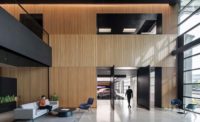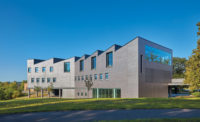San Francisco
Many San Francisco startups inhabit industrial warehouse spaces: the lofty, open structures readily adapt to become modern workshops for artisanal software development. Founded in 2009, the mobile- payments company Square, Inc., which makes credit- and debit-card readers for tablets and smart phones, would have been happy to consider a brick-and-timber warehouse for its headquarters in 2012. But by that time, with a staff that had rapidly grown to 300, there were very few buildings available in the city large enough to accommodate it. So when four levels of a 22-story downtown office building became available, the company signed a lease.
Square founder, Jack Dorsey, selected BCJ to help his company make the leap after touring one of the firm's residential projects, the Creekside House in Woodside, California. The home's contemporary combination of wood and glass helped inform his vision of a more refined work environment.
The company's previous office was self-consciously “startup” in its design: groovy midcentury-modern furnishings and pops of color. For the new offices, the architects established a neutral palette to complement Square's crisp, white branding: light wood finishes, soft gray textiles, and classic furnishings such as Eames Management chairs. “The concept was that the vibrancy and diversity would come from the employees, rather than the surroundings,” says Mottola.
To turn the large sixth floor into a hospitable environment for people instead of computers, Mottola and his team worked with the landlord to add windows on three sides, opening the building to daylight. The existing raised floor turned out to be an asset, allowing all the wiring to be hidden underfoot. But they removed the dropped ceilings to increase the ceiling height in most areas to 13½ feet. Then they sprayed the newly exposed ceiling with cellular insulation for acoustic control and painted it white.
The voluminous 100,000-square-foot main office floor feels surprisingly intimate thanks to precisely detailed gathering areas, including an in-house coffee bar, wool-upholstered nooks, glass-walled meeting rooms, and a library with built-ins made of local eucalyptus. The architects organized the open floor plan around a long central boulevard, which spans the 32-foot width of a whole bay, so that the space is immediately legible from the reception lobby. The boulevard is delineated by carpeting in a lighter shade of gray than the rest of the floor, and flanked by gray columns with softly rounded corners (a nod to the shape of the Square card reader). Overhead, a line of bright LED linear fixtures illuminates the path, while low-level indirect lighting addresses the needs of programmers working nearby.
This interior thoroughfare is bracketed by a conference room at one end and library at the other. In between, a series of upholstered booths, stand-up tables, and sofas are on hand to facilitate quick collaborations. To encourage employees to move about, the designers provided an equal number of informal seating options and workstations (each person is allocated a relatively modest 4 feet). In order to promote an egalitarian environment, none of the workstations are located next to the windows. Instead, a mix of stand-up tables and soft seating are arrayed along the perimeter.
The ultimate tech-startup amenity, a coffee bar, brings the conviviality of a café to the heart of the boulevard. To differentiate it from the workplace, the architects surfaced the popular hangout with concrete and whitewashed end-grain hemlock and eucalyptus. An Italian espresso machine, a Japanese cold-drip system, and a row of single-cup setups offer top coffee-culture options as the baristas play music (on vinyl). Employees pay for gourmet brews via a Square reader at the register (to help them understand the customer experience), but regular coffee is free and plentiful.
Leveraging the firm's work for Apple's retail stores, BCJ designed a version of that establishment's familiar “Genius Bar” for Square's IT help desk. The open bar, in whitewashed eucalyptus with a wraparound solid surface counter, allows employees—now numbering 850—to get assistance with technology problems in a user-friendly setting.
Designed to be more than an elegant upgrade, the new workspace, says Mottola, “underscores the company's goal of making commerce easy for its customers.”
PeopleClient: Square, Inc. Owner: Square, Inc.
Architect:
Personnel in architect's firm who should receive special credit:
Project Team: Architect of record: Bohlin Cywinski Jackson Interior designer: Bohlin Cywinski Jackson
Consultants: Structural: Tipping Mar Lighting: Banks Ramos Architectural Lighting Design Acoustical: Charles M. Salter & Associates AV/Security/Telecom: RLS Food Service: Presidio Design Group, Inc. Life Safety: The Fire Consultants General contractor: BCCI Construction Construction manager: Rockridge Group
Photographer(s): Size: 173,450 square feet Project cost: withheld Completion date: September 2013 |
Products
Glazing Other: Storefront: Wilson Partitions
Doors Metal doors: Door Components Inc. Wood doors: Eggers Industries Special doors: Arcadia Inc.
Hardware Closers: Dorma, LCN Exit devices: Von Duprin Pulls: Ives, FSB Security devices: Schlage, Adams Rite
Interior finishes Suspension grid:Armstrong Cabinetwork and custom woodwork: San Francisco Millwork, Acosta & Sons, Inc. Paints and stains: Glidden Professional, Scuffmaster Wall coverings: Luna Textiles, Carnagie Fabrics, Maharam, Filz Felt Paneling: Plyboo, Exotic Hardwoods Plastic laminate: Pionite Solid surfacing: Caesarstone, Corian Solid Surfaces Special surfacing: Concreteworks Floor and wall tile: Dal Tile: Restrooms, showers, servery walls Resilient flooring: Armstrong, Artigo s.p.A. Carpet: Interface, Inc. Raised flooring: Tate Access Floors, Inc. Reception and Coffee Bar Wood Flooring: Oregon Lumber Company Reception Ceiling: Eurospan Glass Markerboards: Clarus Glassboards Servery Ceiling: Rulon International Metal Baffles: Gordon Finmate Specialty Wood Ceiling: 9Wood Sneeze Guards: BSI
Furnishings Ancillary Furniture: Herman Miller, Mash Studios, Ohio Design, Tolix, Knoll, Design Within Reach, HighTower Conference Tables: Geiger International Fixed seating: San Francisco Millwork, Acosta & Sons, Inc. Upholstery: Maharam, Camira, Designtex
Lighting Downlights: Pinnacle, Litelab, Focal Point, Tech Lighting, USAI Lighting Track lighting: Philips, Translite Sonoma Dimming System or other lighting controls: Crestron
Plumbing Restroom Faucets: Solis
Add any additional building components or special equipment that made a significant contribution to this project: |













Post a comment to this article
Report Abusive Comment